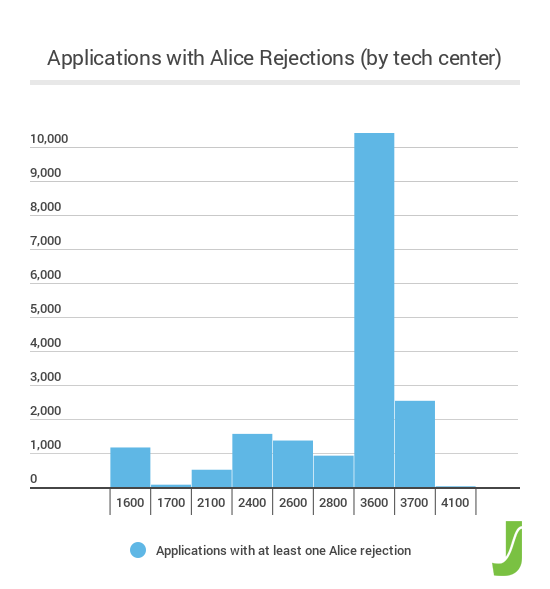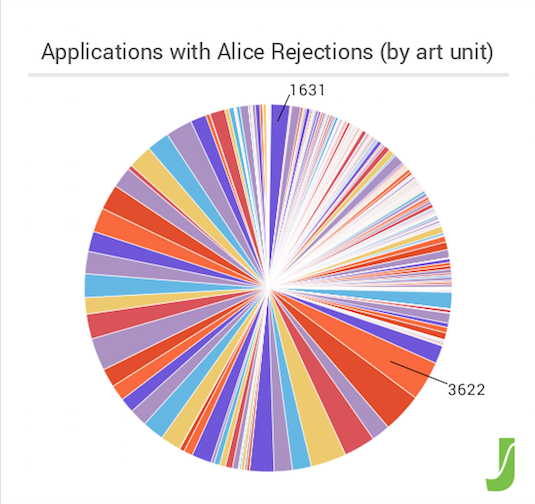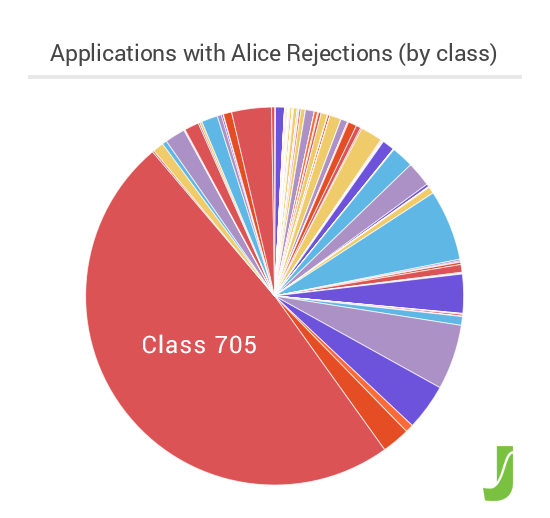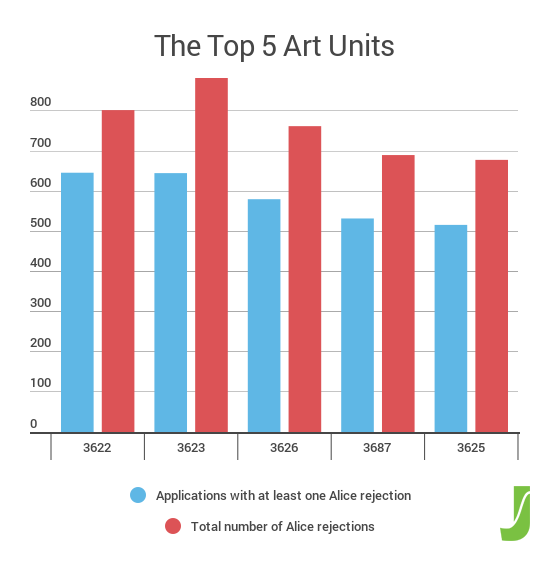 Imagine your client asks you to draft a patent application concerning software for accepting online payment. You cringe because, as any patent professional is aware, these types of software and/or business methods applications have become excruciatingly difficult to prosecute in the wake of the Supreme Court’s decision in Alice Corp. Pty. Ltd. v. CLS Bank Internat’l, et al., 573 U.S. (2014).
Imagine your client asks you to draft a patent application concerning software for accepting online payment. You cringe because, as any patent professional is aware, these types of software and/or business methods applications have become excruciatingly difficult to prosecute in the wake of the Supreme Court’s decision in Alice Corp. Pty. Ltd. v. CLS Bank Internat’l, et al., 573 U.S. (2014).
In particular, Technology Center (TC) 3600 is a hotbed of Alice rejections. In addition to reviewing applications related to national security, animal husbandry, and nuclear weapons, TC 3600 is home to three e-commerce art unit groups.

We used a dataset of over 6 million patent applications and their prosecution histories to measure Alice rejections by tech center (see Figure 1). It’s clear from this analysis that the vast majority of Alice rejections occur in TC 3600.
If knowing that TC 3600, with its three e-commerce art unit groups, is a perilous place for an application to land, it must be even better to be able to predict the individual art unit to which an application will be assigned… right?
Art Unit or Class?
When a patent application is submitted to the USPTO, it is then sorted into a class and subclass based on the subject matter claimed in the application. The USPTO then uses this class/subclass designation to route applications to the appropriate tech center and art unit group. We decided to examine which, then, is a better indicator of the likelihood of receiving an Alice rejection – art unit or class.

As shown in Figure 2, while there are clusters of art units that receive more Alice rejections than others (many of which are in TC 3600), there are others scattered across the USPTO that also receive significant numbers of Alice rejections. For example, while Art Unit 3622 has the highest incidence of Alice rejections (646), Art Unit 1631, in a different technology center, still has a significant amount (310).
However, when we looked at the distribution of Alice rejections by class, it became clear that class is actually a better predictor of an application’s propensity to receive an Alice rejection (see Figure 3).

As is clear in Figure 3, nearly half of all applications with an Alice rejection are assigned to Class 705.
Further, by examining distribution of Alice rejections between the five art units and classes with the most Alice rejections, it’s clear that class is the better indicator. As seen in Figures 4 and 5, the distribution of Alice rejections between the top five art units is relatively even while Class 705 has seen more than twice as many Alice rejections as the next four most common classes combined.


The disparity between the art units is confused even more so when we consider the total number of Alice rejections in each art unit, rather than just counting the total number of applications receiving an Alice rejection. Doing that, we can see that, while 3622 and 3623 have almost equal numbers of applications with Alice rejections, 3623 actually has more in total. This means that applications in that art unit are more likely to receive multiple Alice rejections and take longer to prosecute.
Within each art unit, there are discrepancies between individual examiners. Consider two examiners in Art Unit 3622. Each has examined roughly the same number of applications and has over five years of experience in Art Unit 3622, but have widely varying allowance rates. Examiner A has a 31% allowance rate, while Examiner B has an allowance rate of only 6.5%. Additionally, Examiner A has issued Alice rejections on 34 applications while Examiner B has issued them on only 13 applications. This may indicate that, while Examiner A is more likely to issue an Alice rejection, he is also more likely to eventually grant an allowance. Due to this type of variance, a prediction that your application is likely to land in Art Unit 3622 may not provide the best indication of the likelihood of an Alice rejection.
Figure 5 makes clear that Class 705 is vastly more likely to see an Alice rejection than any other class and is also more likely to see applications with multiple Alice rejections. Thus, anticipating when an application is likely to wind up in Class 705 (Data processing: financial, business practice, management, or cost/price determination) gives the prosecutor a better indication that the application is likely to receive an Alice rejection than predicting an art unit assignment alone.
Better Outcomes with Big Data
Armed with that information, the next question is how to go about predicting when an application is likely to be assigned to TC 3600 and/or Class 705. By using big data, we are able to help patent practitioners ascertain and alter the probability that their applications will be assigned to particular classes and technology centers.
Class 705, with an overall allowance rate of only 48.6%, is clearly an undesirable destination for an e-commerce patent application. By using big data analytics, we can narrow down the specific words that are steering an application toward a particular class. Altering these words allows a patent practitioner to change the odds of an application being assigned to a tech center or class with a higher allowance rate, or to one in which an attorney or firm has performed well in the past. For example, the words “loan” and “auction” are strongly associated with an application’s assignment to Class 705.
Ultimately, while we always talk about technology center and art unit assignments, class is a far better predictor of an application’s chances of success, particularly when it comes to the recent uptick in §101 rejections in the wake of Alice. With the ability to use big data to alter the likelihood that an application will be assigned to a particular class or tech center, attorneys can make more informed strategic decisions for their clients, obtain better results at the USPTO, and increase the value of their services.
Image Source 123RF.com
Image ID : 30856712
Copyright : dazdraperma

![[IPWatchdog Logo]](https://ipwatchdog.com/wp-content/themes/IPWatchdog%20-%202023/assets/images/temp/logo-small@2x.png)

![[Advertisement]](https://ipwatchdog.com/wp-content/uploads/2024/04/UnitedLex-May-2-2024-sidebar-700x500-1.jpg)
![[Advertisement]](https://ipwatchdog.com/wp-content/uploads/2024/04/Artificial-Intelligence-2024-REPLAY-sidebar-700x500-corrected.jpg)
![[Advertisement]](https://ipwatchdog.com/wp-content/uploads/2024/04/Patent-Litigation-Masters-2024-sidebar-700x500-1.jpg)

![[Advertisement]](https://ipwatchdog.com/wp-content/uploads/2021/12/WEBINAR-336-x-280-px.png)
![[Advertisement]](https://ipwatchdog.com/wp-content/uploads/2021/12/2021-Patent-Practice-on-Demand-recorded-Feb-2021-336-x-280.jpg)
![[Advertisement]](https://ipwatchdog.com/wp-content/uploads/2021/12/Ad-4-The-Invent-Patent-System™.png)






Join the Discussion
10 comments so far.
Bill
June 7, 2016 11:31 amJust to be sure its the old USPC Classification System being referred to –
Class 705: Data processing: financial, business practice, management, or cost/price determination;
Subclass 1.1: AUTOMATED ELECTRICAL FINANCIAL OR BUSINESS PRACTICE OR MANAGEMENT ARRANGEMENT
TJM
June 7, 2016 08:38 amAlex,
Your comment assumes that a patent that should have been classified in 705 should not be patentable, and that a court will view this type of technology the same way as the PTO should. I can tell you that this is not the case. The goal is not to “sneak” anything past the Patent Office; rather, the goal is to obtain robust, valid protection for our clients’ inventions. If you believe that the majority of examiners in TC 3600 are justified in their Alice/101 rejections, you are more than welcome to advise your clients accordingly. But reasonable people can disagree about TC3600’s current practice, and there is nothing sneaky about tailoring a patent application to give the applicant the best chance for obtaining protection.
Anon
June 7, 2016 06:14 amAlex,
“Sneak” is a pejorative.
ALL items are subject to USPTO’s post grant review of IPR (it is only the CBM that is more selective).
To even make it to a point of protection, one must first obtain the patent. This is less about “sneaking through” and more a realization that certain art units within the Office simply “just say no” to items that DO deserve patent protection.
It is important here to NOT assume that those same certain portions of the Office are actually acting providently by denying grants to patents that simply do not deserve to be granted (as is implicit in your comment).
Alex in Chicago
June 6, 2016 11:36 pmWait, why are we trying to figure out ways to sneak patents through the USPTO that will be unenforceable in the courts? Or, at best, will subject our clients to one of the USPTO’s post-grant review?
Curious
June 4, 2016 11:00 pmIf you make the technological core the foundation of the patent application and avoid financial terminology where at all possible, you should wind up in a computer technology class.
Easier said than done. The invention is what it is — e.g., you will be hard pressed to transform a mechanical device into a biotech invention. Still, even if you can couch you invention in technological language, doing so probably significantly limits the scope of the invention.
TJM
June 4, 2016 08:14 pmThis is a good article. A further refinement might be to drill down within subclasses of 705 to see if additional aspects or characteristics can be identified that are more likely to trigger an Alice rejection.
Justin Blows
June 4, 2016 05:00 pmThis is a very useful analysis. I guess for commercial reasons the Author has not revealed how to avoid having an application assigned to this class.
“Technical” is clearly the defining feature of a software patent these days (see for example the tables here: http://softwarepatentsconsidered.com/software-patent-examples/)
Focusing on technical aspects of software, in all parts of the application, appears to be the essential.
Mark Nowotarski
June 1, 2016 10:11 amCurious @2: if your technology squarely resides in a field that is classified as a “business method,” there isn’t much you can to change it.
As a practitioner specializing in business methods, I find it a rewarding challenge to dig deep enough into a client’s business invention until we find the technological core. That invariably means detailed discussions with the developers in IT as to why exactly they set up a system for a new financial product the way they did. If you make the technological core the foundation of the patent application and avoid financial terminology where at all possible, you should wind up in a computer technology class.
Curious
May 31, 2016 03:29 pmI guess the $64,000 question is how to avoid TC 3600 and/or Class 705, or if you are stuck in it, how to get out.
Anybody who has been practicing before TC3600 for any length of time can tell you (without the analytics) that it is the he11hole of the USPTO. It has been that way for at least a decade — well before the terms Bilski or Alice meant anything to anybody.
A couple of easy suggestions is never but the terms “business,” “commerce,” “marketing,” or any synonyms thereof anywhere in your application. I have had applications transferred to me in which the term business was found in the Title, the Abstract, and half-a-dozen times in the independent claim — no surprise to what TC these applications were shunted.
Unfortunately, I get national phase applications that I really cannot do much with, and the foreign attorneys (who drafted the applications) just don’t understand how much worse the application will be treated if it goes to TC3600 instead of say, TC2100.
Regardless, if your technology squarely resides in a field that is classified as a “business method,” there isn’t much you can to change it.
Night Writer
May 31, 2016 12:54 pmThis is really data to see. I guess the $64,000 question is how to avoid TC 3600 and/or Class 705, or if you are stuck in it, how to get out.